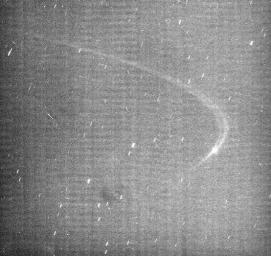Cassini images reveal the existence of a faint arc of material orbiting with Saturn's small moon Anthe.
The moon is moving in a counterclockwise direction in this perspective, and is about to reach the ansa—the point of maximum elongation—as seen by the viewer, in its curving path around Saturn.
In this image, most of the visible material in the arc lies ahead of Anthe (2 kilometers, or 1 mile across) in its orbit. However, over time the moon drifts slowly back and forth with respect to the arc. Also ahead of the moon is a dark channel where the arc appears split into two strands, and these then merge farther around the orbital path. The arc extends over about 20 degrees in longitude (about 5.5 percent of Anthe's orbit) and appears to be associated with a gravitational resonance caused by Mimas. Micrometeoroid impacts on Anthe are the likely source of the arc material. The orbit of Anthe lies between the larger moons Mimas and Enceladus. Anthe shares this region with two other small moons, Pallene (4 kilometers, or 3 miles across) and Methone (3 kilometers, or 2 miles across). Methone also possesses an arc (see PIA11102), while Pallene is known to orbit within a faint, complete ring of its own (see PIA08328).
Cassini imaging scientists believe the process that maintains the Anthe and Methone arcs is similar to that which maintains the arc in the G ring (see PIA08327). This view looks toward the un-illuminated side of the rings from about 3 degrees above the ringplane. The view has been rotated so that Saturn's north pole would point upward. The general brightness of the image (along with the faint horizontal and vertical banding pattern) results from the long exposure time of 32 seconds required to capture the extremely faint ring arc and the processing needed to enhance its visibility (which also enhances the digital background noise in the image). The image was digitally processed to remove most of the background noise. The long exposure also produced star trails in the background. The image was taken in visible light with the Cassini spacecraft narrow-angle camera on April 4, 2008. The view was acquired at a distance of approximately 1.2 million kilometers (746,000 miles) from Anthe and at a sun-Anthe-spacecraft, or phase, angle of 23 degrees. Image scale is 7 kilometers (4 miles) per pixel.
The Cassini-Huygens mission is a cooperative project of NASA, the European Space Agency and the Italian Space Agency. The Jet Propulsion Laboratory, a division of the California Institute of Technology in Pasadena, manages the mission for NASA's Science Mission Directorate, Washington, D.C. The Cassini orbiter and its two onboard cameras were designed, developed and assembled at JPL. The imaging operations center is based at the Space Science Institute in Boulder, Colo.
For more information about the Cassini-Huygens mission visit http://saturn.jpl.nasa.gov/. The Cassini imaging team homepage is at http://ciclops.org.

 Planetary Data System
Planetary Data System












